From
my recent diary
2020
Unless
otherwise noted I use the following materials since the end of October,
2018.
Telescope: D: 45.5cm f: 2037mm
Dobsomian (Newtonian reflector)
Eyepiece: and magnification: Lavendura
63mm, apparent FOV 45 deg. with Paracorr
@@@@@@@@@@@
@
x37, actual FOV 1.2 deg.
Night Vison: ACT
PVS-14 Photonis 4G INTENS 1800 Auto gate P45 WP
Wednesday, December 23 and Saturday, December 26
It was the 10th comet hunting session on Wednesday and the 11th on
Saturday.
Wednesday
When I arrived at the observing site it was cloudy with the cloud coverage
of 90%. I believed that it would be clear soon, and I started to set up my
telescope. Then, the sky got perfectly clear in half an hour. I got myself
ready and began to comet search 40 minutes after the arrival. I used Ethos
21 mm 97x with 46 cm Dobsonian, because both transparency and seeing was
excellent.
On Monday I completed comet hunting after identifying a globular cluster
in Virgo, NCG5634. I did that continuation today and began with the
cluster. I pulled down my comet seeker toward the horizon from an altitude
of some 30 degrees. I have had less experience searching this area, the
eastern part of Virgo, because in Tohkamachi, Niigata where I had lived
until March 2018, we had few fine days especially in the latter half of
December and I had less opportunity to sweep the area that rises in the
eastern sky at predawn. Having said so, it turned out referring my diary
that I spent 11.7 hours with 9 times of searching sessions including 3
times of observing expeditions to Gunma Prefecture etc. in December 2002,
and 16.2 hours with 11 times including one observing expedition to Nagano
Prefecture in December 2010. http://comet.la.coocan.jp/diary/2019-diary.html#statistics-2019
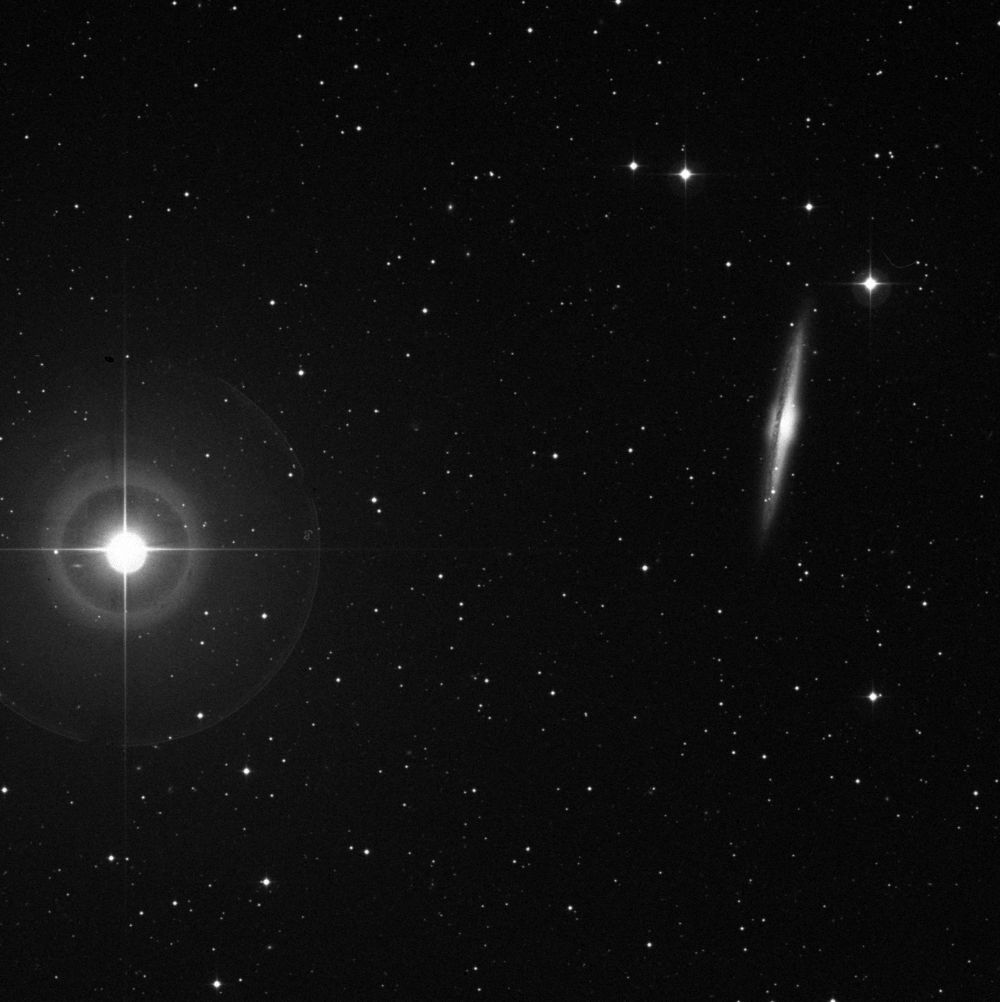
Galaxy NGC5746 (right) that has a dark lane and 4th magnitude silver
yellowish star109 Virginis. The image is 30' wide. The Digitized Sky
Survey copyright © 1994
I identified 20 galaxies and 2 globular clusters in total in the session,
e.g. NGC5300, 5363-5364, 5576-5577, 5651 c "-" represents the galaxies
were observed in the same FOV. I had an impression that there are less
galaxies in the area but unexpectedly, it includes a lot of them. The most
beautiful one was NGC5746 that is an edge-on galaxy 20' west of 4th
magnitude star 109 Virginis. The dark lane as if it would symbolize the
deep universe is emphasized by 109 Virginis, silver yellowish star. For me
they look like Black belt in martial arts and the shine of katana.
M5, a globular cluster in Serpens, came into the FOV at 6:00am local time
12 minutes after the beginning of the twilight. The stars in the cluster
were resolved into individual one with pinpoint image thanks to excellent
seeing. I rarely experienced such things in Niigata in winter, which was
also impressive!
Saturday
Air temperature was -3C, not very low, at 3:46am when I arrived at the
site. However, I felt chilly due to weak wind. I began with M5 as a
continuation of Wednesday's session. Seeing was excellent and I used Ethos
21 mm, 97x again.
The first object I observed was a galaxy in Serpens, NGC5921. The next was
a globular cluster in Ophiuchus, M12 at an altitude of 7. M10 that is in
the vicinity of M12 was behind the mountain with an altitude of 3, and
did not came into the FOV. I observed four more galaxies in Serpens,
NGC5970, 5953-5954 and 5962. I finished the session when Venus and Antares
rose. It was a beautiful daybreak with morning glow around Mt. Sobosan.
Sunday, November 15
It had been clear sky throughout the week Monday through Sunday,
today. I have comet hunted every day, i.e. seven consecutive days at
predawn. I wrote in "Diary" in August that I conducted comet hunting for
six days in a raw that was a record high, but it was broken easily. Such
record was impossible to archive in Niigata where I have ever lived,
because the weather is unstable and the fine days does not hold. It is the
third year for me since I started living in Kumamoto, and I think this may
be the normal weather here. It might have been exceptional nasty climate
for the two years.
Today, I observed C/2020 M3 ATLAS and C/2020 S3 Erasumus before the
hunting session. First, I used 46 cm 97x, Ethos 21 mm. The magnitude of
C/2020 M3 was 7 to 8th and an apparent diameter of 10' with a wide and
short tail. C/2020 S3 was 7th magnitude, the diameter of 4' but I could
not recognize a tail.
Second, I employed Night Vision Device (NV), 37x. The magnitude and the
apparent diameter of C/2020 M3 were 8th and 3', respectively. The apparent
diameter observed using NV was only one third of that estimated by Ethos
21 mm. This was because the faint outer coma was not be seen by NV. The
total magnitude was a bit dimmer with NV in comparison with Ethos 21 mm.
The diameter and the magnitude of C/2020 S3 measured by NV were,
respectively, 2' and 8th. It looked fainter than using Ethos 21 mm, but I
observed a tail with NV.
In summary, the two comets looked brighter and easier to see with Ethos 21
mm.
Today, I decided to use a glass eyepiece instead of NV because of the
result. However, I adopted a combination of Planokular 30 mm and Paracorr,
i.e. 78x, due to poor seeing instead of Ethos 21 mm. The magnification of
97x with Ethos 21 mm was too high that made star image swell.
I swept the galaxy group in Virgo and Coma Berenices on Friday, and
identified 89 galaxies for an hour and a half. Yesterday, I had a plan to
search the sequel to the region, but instead I did the southeast due to
strong northeastern wind; I used my car as a windbreak and setting up my
telescope. Today, I began with M100 so that the searching area connected
with that of Friday.
In contrast to yesterday's session, it was windless and comfortable
conditions with air temperature of 9ºC. The altitude of M100 was 25º.
NGC4312 (magnitude of 11.6), located 17' south of M100, was easy to see
but another galaxy, NGC4328 (13.4), 5' east of M100 was challenging and
need to see very attentively. Zodiacal light looked brighter than usual
that made the limiting magnitude worse. I spotted 24 galaxies and a
globular cluster (NGC4147) for half an hour, and additional five galaxies
for extra an hour after when I got out of the area of the galaxy group.

Mercury was some 1.5º west of the thin crescent moon. Venus (upper right),
Spica (lower right of Venus) and Arcturus (upper left).
Nov. 14, 2020 JST, iPhone X Click to enlarge

Venus and the crescent moon. Oct. 14, 2020 JST, iPhone X
Click to
enlarge
During the searching session, I saw Venus, Spica and Mercury rose one
after another, but the moon was not unlike yesterday and earlier. I missed
that. Actually, it was a new moon today. I was impressed by the scenery
that the last quarter moon gradually waned and approached Venus on Friday.
Then, the thin crescent moon was within 1.5º of Mercury on Saturday. In
the background, there is a sacred mountain, Mt. Sobosan, which made those
heavenly bodies diviner. Sunrise glow becomes more wonderful than the
photo taken on Nov. 14 under excellent transparency like the photo taken
on October 14. Having such an experience made me happy.
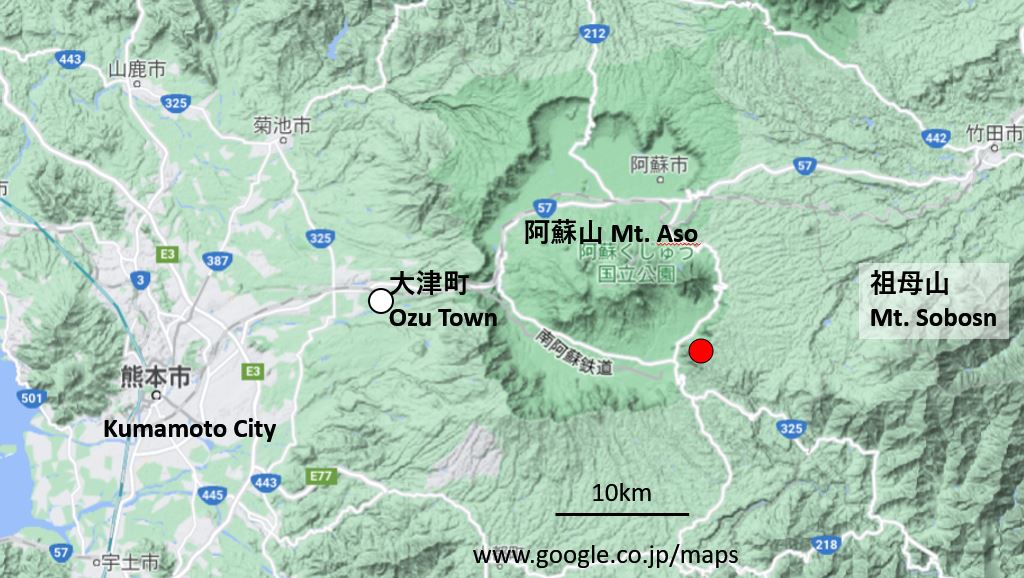
Red circle indicates new observing site. It is located at the southeastern
outer rim of the volcanic crater of Mount Aso, some 25 km east of Ozu Town
where I live.
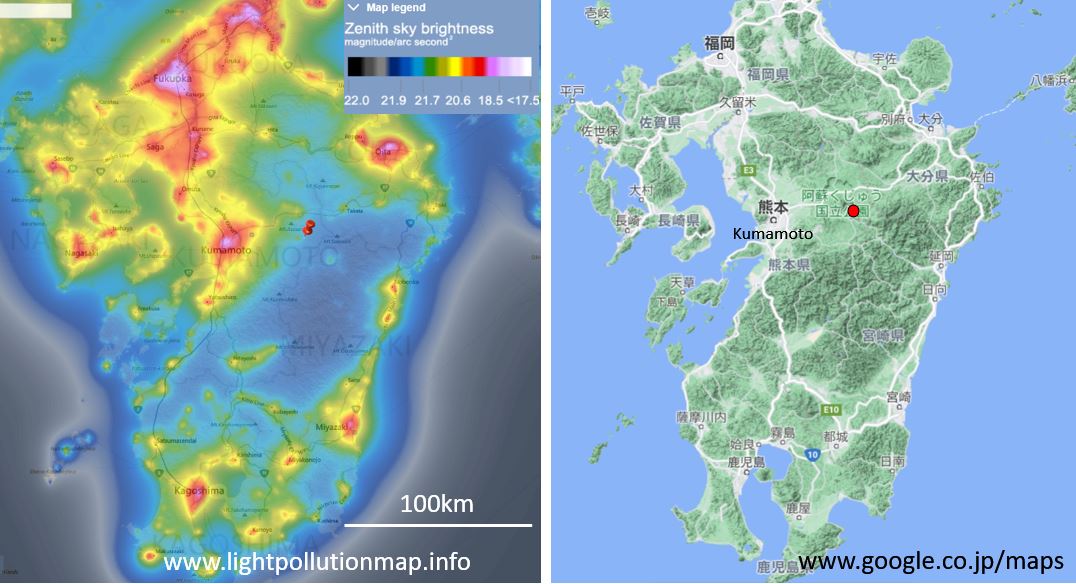
Light pollution of the east and the south is less at the site (red
circle).
I started to go to a new observing site located at the southeastern outer
rim of the volcanic crater of Mount Aso since this August. The site
commands a good view of Mt. Sobosan where light pollution is less in the
east and the south.
Sunday, October 25
Night Vision and glass eyepiece: from the view point of comet
observation
Before the start of today's comet hunting session, I observed C/2020
S3 Erasumus and C/2020 M3 ATLAS. I estimated C/2020 S3 as the magnitude of
11 with apparent diameter of 2' using Night Vision (NV) 37x, while I did
as the magnitude of 10 and 4' in diameter using Ethos 21 mm, 97x. Both
estimations were made by intuition and not based on the measurement using
comparison stars. Obviously, C/2020 S3 looked brighter with the glass
eyepiece than with NV. Shogo Utsunomiya reported that the comet showed
blue color in photos in the same way as C/2020 A2 Iwamoto. As I mentioned
in "Diary" on Jan. 21 this year,
it is confirmed that comets with blue color are invisible or difficult to
observe with NV. NV is not suitable for blue comets.
C/2020 M3 was observed as the magnitude of 9 and apparent dimeter of 3'
using NV, while it was 9 and 10' with Ethos 21 mm. I could not recognize
the outer part of faint coma of the comet with NV. NV is very effective
for the objects with continuous spectrum, and much superior to the glass
eyepiece under the moonlight and/or hazy sky condition. However, the
drawback is that it does not work well for blue comets, and I decided to
give priority to use the glass eyepiece under the good sky condition. When
the sky is clear comets look better with the glass eyepiece than NV in
many cases, though it is not always true.
Today's comet hunting session
At 3:53a.m. local time I began the session with M105, a galaxy in the
constellation of Leo. I identified 49 galaxies in total, because I got
into the area of the group of galaxies in Coma Berenices and Virgo. I
could notice three out of four galaxies in the galaxy group with NGC3190
that is located at the neck of Leo: NGC3190 (magnitude of 11.1), 3185
(12.0) and 3193 (10.8). I saw the exitance of the remaining one, NGC3187
(12.9) that is in the vicinity of NGC3190, when I checked them usin the
digital map, SkySafari 6 Pro. I looked into the eyepiece and spotted it.
The galaxy group was at the altitude of 36 above the horizon when I
observed, but it was challenging to recognize NGC3187 because of bright
zodiacal light. Though I remember I have ever seen the dark lane in
NGC3190, I could not this time.
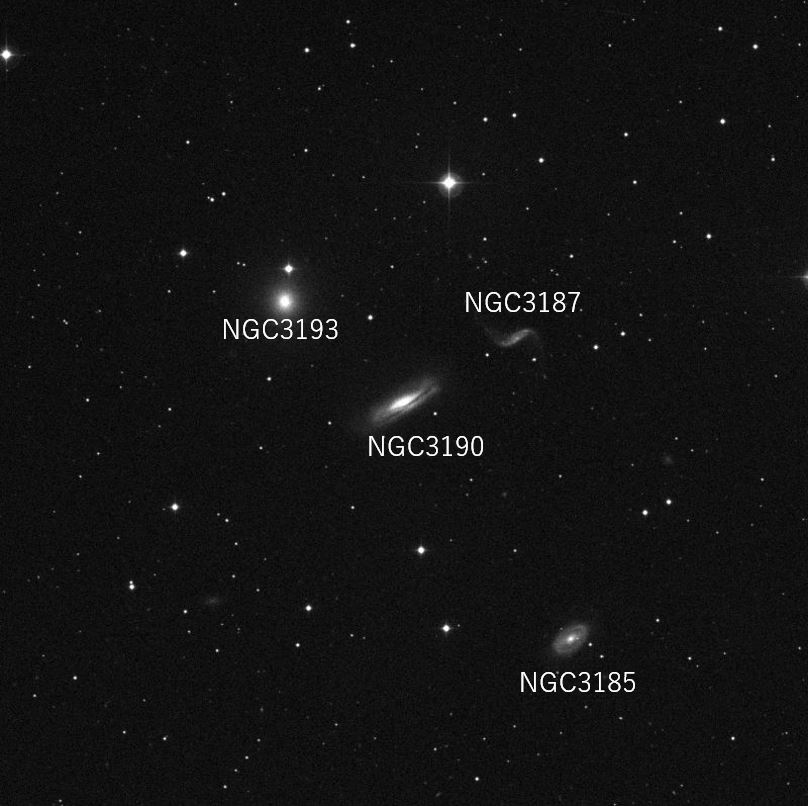
Galaxy group with NGC3190. The image is 30' wide.
The Digitized Sky Survey copyright © 1994
The galaxy group at the base of the rear foot in Leo including three
galaxies, NGC3605 (magnitude of 12.1), 3607 (9.9) and 3608 (10.7), came
into the FOV. I identified them with SkySafari 6 Pro. I noticed another
galaxy, NGC3599, was on the digital map in the same FOV. I peered into the
eyepiece, and definitely, I could see it. The galaxy group was 25 above
the horizon at that time. Then, I identified major galaxies in Markarian's
Chain at the low altitude of 20 or less to complete the session.
I could have encountered more galaxies if I had employed NV. I might have
discovered a dust rich new comet with continuous spectrum. Having said so,
I have only two options: NV or a glass eyepiece. There is no royal road,
and I sweep the sky in the way what I think the best and what I feel
enjoyable at the time.
Monday, September 21
On my way to the observing site, I was sitting behind the wheel and
saw the brave figure of Orion rising on the east. At the site wonderful
starry sky welcomed me. I felt I would never get bored enjoying the star
gazing by naked eyes, and as if the day would have broken soon. I did not
lose temptation of naked eyes observation and I stared setting up my comet
seeker.
Prior to the comet-hunting session I tried to observe C/2020 Q1 Borisov
and C/2020 M3 ATLAS. Seiichi Yoshida's site read there was an observation
that reported C/2020 Q1 was 11th magnitude visually. I expected the comet
could be seen using my 46-cm telescope with ease, but I could not. Though
I specified the position comparing the FOV with the digital map many
times, I failed to observe it.
When I observed C/2020 M3 on September7 under the moonlight, I estimated
the comet as 9th and 10th magnitude using NV and Ethos 21 mm,
respectively, by intuition. However, this time the comet was 12th
magnitude in both NV and Ethos 21. That meant the comet had reduced its
magnitude.
I think all the above-mentioned observations were correct, because in my
experience the magnitude of comets can change drastically and irregularly.
The chance of discovery is strongly dependent on the comet hunter
encountering a change event when the comet increases its brightness during
the irregular variation.
At 3:31am local time I began the comet searching session with Sirius,
alpha Cains Majoris, towards the north because of a chance of the
discovery of the sungrazing comet. I used Ethos 21 mm, 97x, instead of
Night Vison Device as the transparency was excellent.

Melotte 71. The image is 60' wide.
The Digitized Sky Survey copyright © 1994
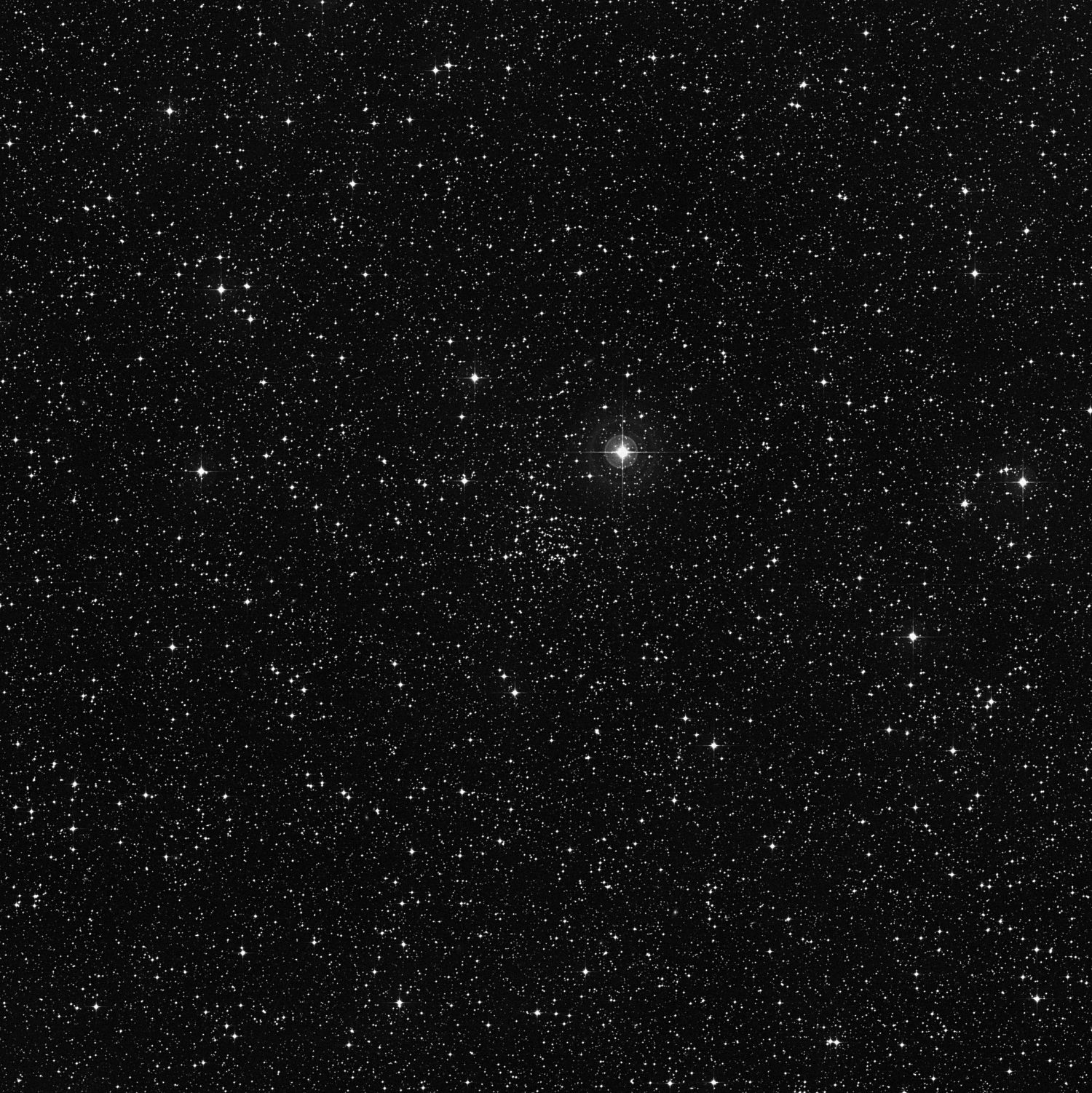
Melotte 72. The image is 60' wide.
The Digitized Sky Survey copyright © 1994
Impressive DSOs
M93, an open cluster in the constellation of Puppis came into the FOV at
an altitude of only 7 above the horizon, which sparkled dazzlingly in the
FOV. The light of stars looked natural as I employed the glass eyepiece
instead of NV. The next DSO I observed was an emission nebula in Canis
Major, NGC2359, Thor's Helmet, which has a unique shape. I saw the nebula
many times, but it stands out in the region where open clusters are major
DSOs. M50 is a star cluster that comprises of some bright stars. I peered
the cluster for a while and I felt as if I had been sucked into the
darkness in the background of it. I wished I could have looked at it
evermore. NGC2438, a planetary nebula, stood out in M46, and added an
accent to the open cluster. It looks ring-shape using a high
magnification, but I did not want to spend time to do that and went ahead.
Both Melotte 71 and 72 were finespun open clusters. They are not as flashy
as Messier Objects but have really elegant atmosphere.
Today, I could not encounter a new comet again. However, in the first
place, it is satisfactorily if only I find pleasure and impression meeting
with gorgeous starry sky. When I was about to complete the session, the
constellation of Leo that followed Venus, a dazzling goddess, rose above
the horizon.
Saturday, August 15 through Thursday, August 20
It had been heavy rain and cloudy throughout June and July, and I
comet hunted only once in each month. It was 22 July when I observed a
bright comet C/2020 F3 NEOWISE that appeared for the first time in a while
using 15x110 mm binocular, but I did through thin cloud at that time. The
next observation was on 29 July under the moonlight but I failed to see it
with a naked eye.
It had been clear sky and I conducted comet hunting sessions six
consecutive nights since Saturday, 15 August. I have ever comet hunted for
four straight days but six days is a new record.
Saturday, August 15 (Dusk)
Saturday through Sunday, I went observing at Gokase Highland Ski Resort
with an altitude of 1300 m above sea level where some people say the sky
is the darkest in Western Japan. First of all, I observed C/2020 F3
NEOWISE using 46 cm and Ethos 21 mm. The comet was 6th magnitude with a
0.6-long tail. I also observed 246P NEAT with a magnitude of 14.
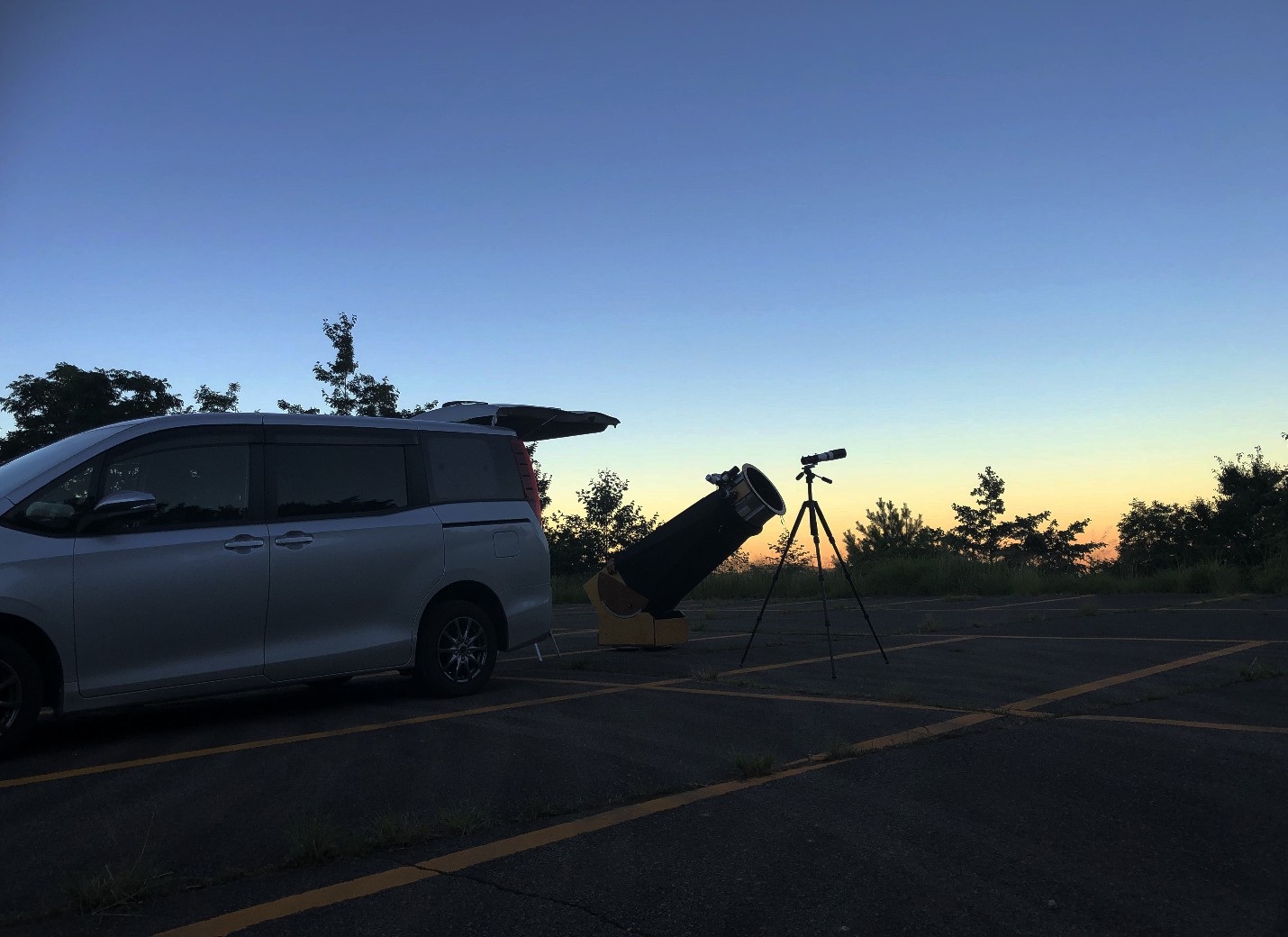
Gokase Highland Ski Resort
Then, I enjoyed observing and photographing using BORG 60ED f350mm 5.6x
with HΏfilter and Night Vision (NV). The exposure was limited due to fixed
shooting that made the photos grainy, however, the visual image of the
objects looked smoother and finer than the photos shown below.
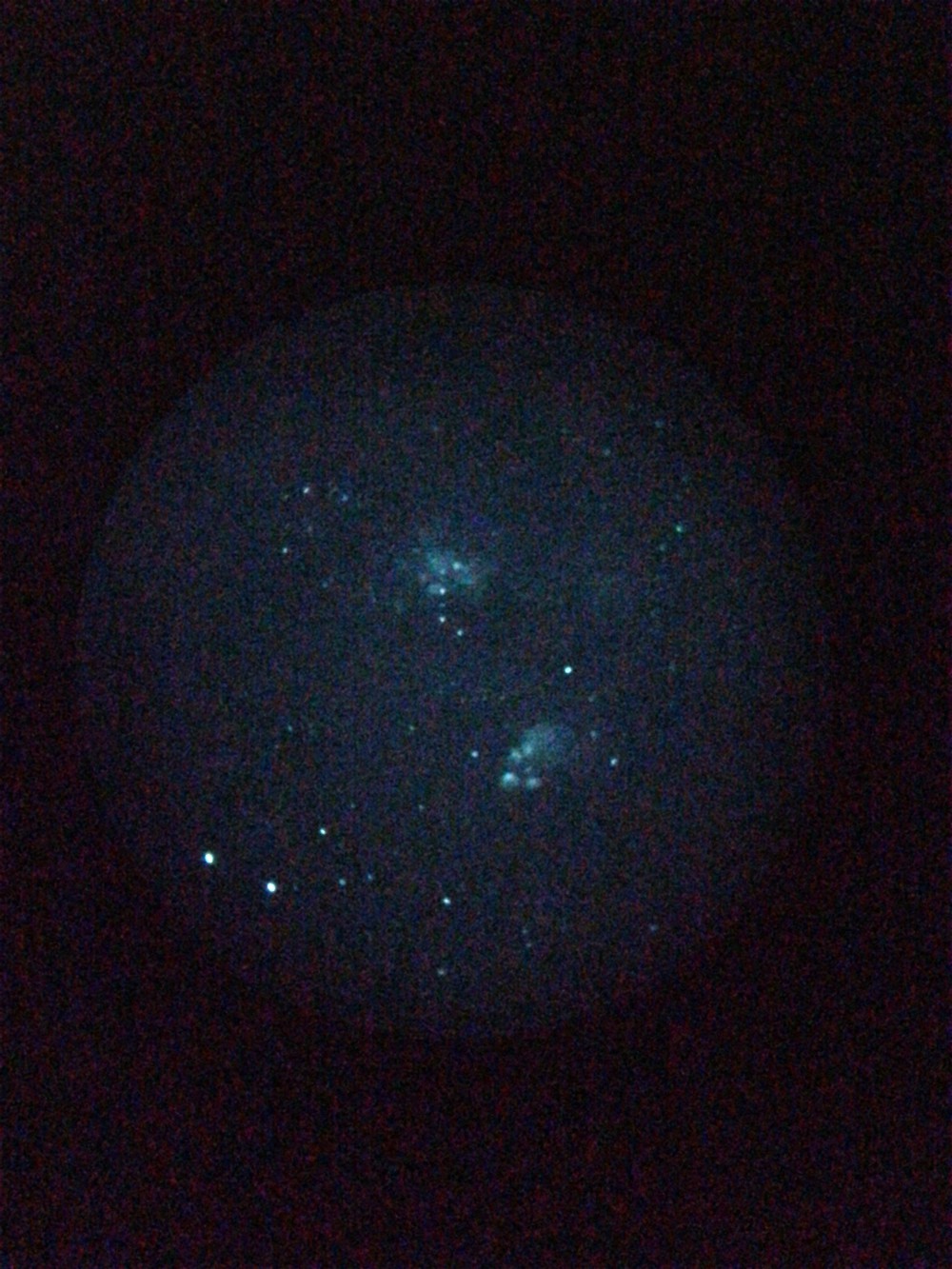
NGC6357 (upper object) and NGC6334
August 15, 20:15 JST, 2020
BORG 60ED f350mm Lavendura 63mm 5.6x, HΏ filter 7nm, Night Vision PVS-14,
iPhone X, ISO 8448, Exp. 4.37sec. (1/3sec x13average), fixed shooting,
diagonal mirror
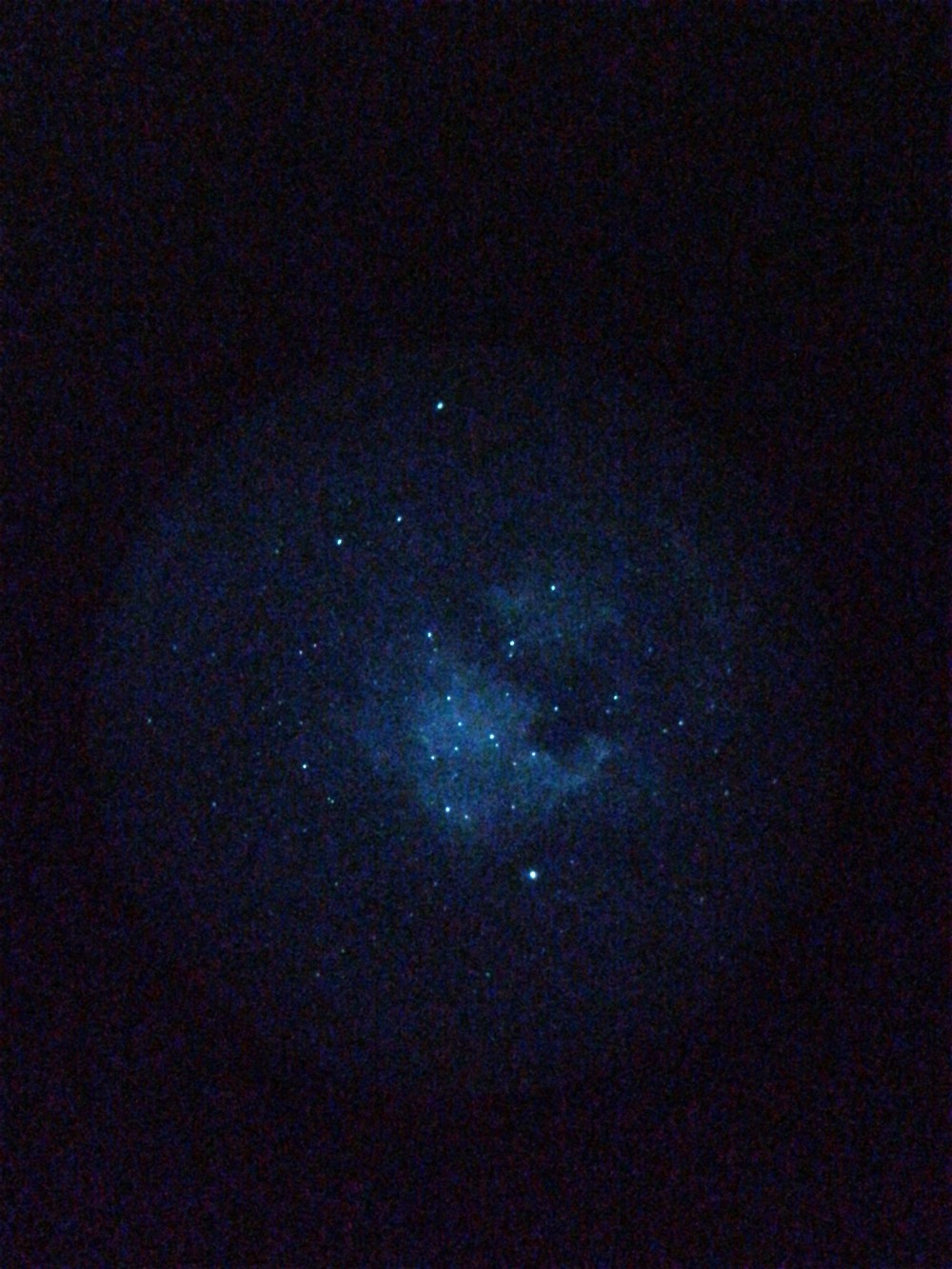
North American Nebula
August 15 20:19 JST, 2020.
The other data were the same as those of NGC6357 and NGC6334
I also shot a spiral galaxy NGC6946 that is at the boundary between
Cepheus and Cygnus. The image shown below is similar to that of visual one
through NV. I observed M17 and M8 using a combination of NV and HΏ filter,
and they looked the same with long exposure photos except for color, i.e.
NV's image is white and black. As I have experienced, the difference in
visibility between NV and a grass eyepiece is small at dark site; using
the grass eyepiece I could see the same feature of those objects with that
of the long exposure photos, though the image was fainter.
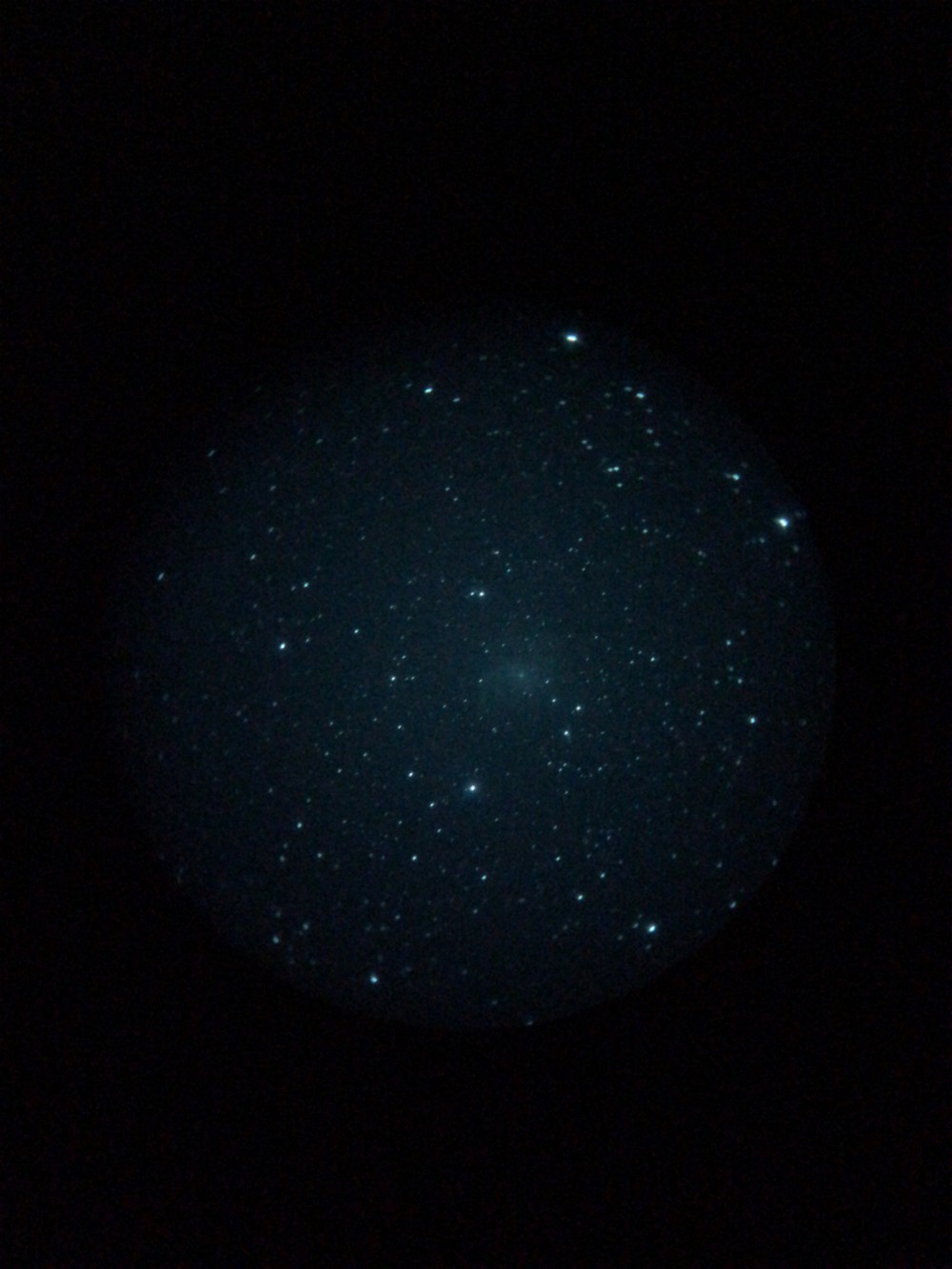
NGC6946
August 15, 22:58 JST
46cm f2037mm, Lavendura 63mm + Paracrr, 37x, Night Vision PVS-14, iPhone
X, ISO 2000, Exp. 2.37 sec. (1/3x7average), fixed shooting. The object is
at R.D. +60 that enabled more than 2 seconds of exposure.
I started the hunting session with M4, and identified 22 DSOs mostly
globular clusters. This time I employed Ethos 21 mm instead of NV. I
enjoyed natural color of stars and beautiful contrast of double stars with
the grass eyepiece.
I tried to observe Encke's division of Saturn using 46 cm 509x, as the
seeing was rather good. I could surly recognize the division with carful
observation during the moment when seeing was stable. I have ever tried to
several times, but failed. I think it was because seeing in Tohkamachi,
Niigata where I have lived for 17 years was poor due to the topography.
Anyway, I saw it for the first time.
Sunday, August 16
After having a nap, I observed Mars at 2:30am local time. I tried to
observe the satellites but could not.
I began the comet hunting session with Regel at 3:07am. Again, I used
Ethos 21 mm instead of NV. There are many 11 to 12th magnitude galaxies
around the region. I encountered NGC1700 in the constellation of Eridanus,
NGC1587, 1588 and 1589 in Taurus and NGC1684 in Orion. M42 was impressive
and M78 was clear but Flame Nebula (NGC2024) and Horsehead Nebula were not
seen because of the moonlight.
Monday, August 17
I headed for usual observing site from home. At first, I started a comet
searching session using Ethos 21 mm, but I replaced it with NV because of
poor transparency. At 3:38am local time Hubble's variable nebula that
looked like a comet with a tail at the altitude of 10 above the horizon.
After that M1 came into the FOV. M35 with NGC2158 were gleaming in the
same FOV. When I have completed the session Winter Triangle rose above the
horizon and Venus shined that was the icing on the cake.
Tuesday, August 18
Contrary to yesterday, transparency was excellent. M33 could be visible
with a naked eye and direct vision. Some 40 years ago, the era with less
light polluted, I used to observe M33 with a naked eye and direct vision.
However, in Niigata I have never seen it with direct vision but could
manage to recognize it with averted vision. Using 46 cm and Ethos 21 mm
the spiral arms were thick and obvious and surrounded around the central
core more than 180. Impressive!
I comet hunted employing Planocular 30 mm + Paracor, 78x, instead of Ethos
21 mm, 97x, since seeing was a little poor. I began with Venus shining in
Gemini, through Pollux and Castor and completed in the constellation of
Lynx. As usual I overlooked Eskimo Nebula, NGC2392, because small apparent
diameter and brightness made it difficult to distinguish the object from a
star (I could spot the nebula on Monday, August 24). As a result, I
identified none of comet-like objects this time.
Wednesday, August 19
I began the session with Castor. The major region of the today's session
was Lynx. Open cluster in Auria was splendid. Transparency at low altitude
was very poor. The only comet-like object I encountered was the 12th
magnitude galaxy in Lynx, NGC2344.
Thursday, August 20
Until yesterday, I swept from the east to the north and reached to Ursa
Major. Today, I went to down to the south and began with gamma Eridani.
The first DSO I observed was M79, a globular cluster in Lepus, and the
second was NGC1832, a galaxy in the same constellation. The total number
of galaxies I identified was 13. Among them the most impressive was a
group of galaxies in Eridanus: NCG1721, 1723, 1725 and 1728. They were in
the same FOV.
I really enjoyed observing and the hunting sessions for six consecutive
days that included remarkable experience like observing Encke's division
and a naked eye observation of M33 with direct vision.
Thursday, July 2
Upon arriving at the observing site the amount of cloud was 80% of the
entire sky, and the eastern sky was cloudy. I thought I was clouded out
again but waited for a couple of minutes. Then, clouds disappeared
rapidly. I set up my telescope and started comet hunting from Mars.
Transparency of the sky was rather good and I identified 12 galaxies in
total, though sometimes clouds appeared mainly at a low altitude.
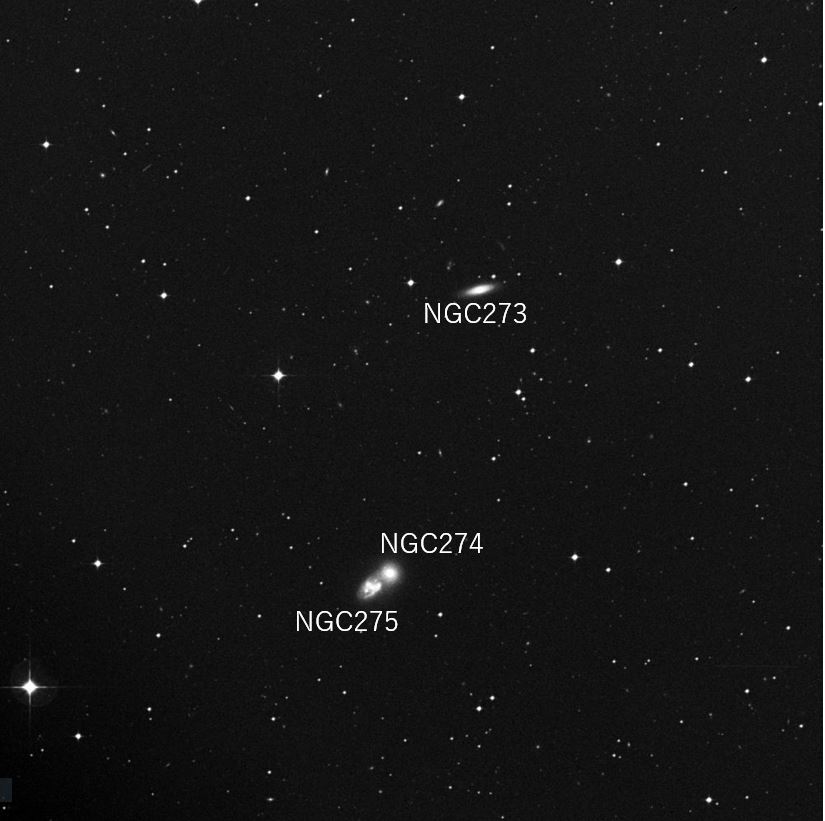
NGC273 (magnitude of 12.9), NGC274 (11.8) and NGC275 (12.5). The image is
30' wide.
The Digitized Sky Survey copyright © 1994
I confirmed two galaxies, NGC274 with the magnitude of 11.8 and 275 with
12.5, both were in the same FOV using SkySafari 6, a digital map. Then, I
noticed another one in the map, i.e. NGC273. I could definitely recognize
NGC273 with carful observation, though the object was faint.
The darkest galaxy in today's session was IC1575A with the magnitude of
13.7 and the next was NGC984 with 13.6. Both of them have small apparent
diameters, and I might had overlooked if I had been careless. I could
manage to tell them from stars. In other words, in spite of the darkness
of them, as dark as nearly 14th magnitude, those galaxies were identified
because they have high degree of concentration. Contrary, I overlooked
NGC273 with the magnitude of 12.3, because somewhat large apparent
diameter of the galaxy reduced the surface brightness.
During the session I took breaks twice to observe the 11th magnitude comet
58P Howell. However, I failed to observe the comet both times using Night
Vison and Ethos 21mm applying LPS-P2, a light pollution filter, and
Lumicon Comet filter.
A beautifully glittering star, Venus, rose in the eastern sky with the
magnitude of -4.5. I had a plan to observe Mars, Jupiter and Saturn after
the session, but the entire sky was covered with heavy clouds as soon as I
finished comet hunting session. I enjoyed short-lived clear sky that
lasted only at the time of the searching session.
Monday, June 22
I got up at 12:50am local time, and headed for the observing site on
the northern rim of the crater, Mt. Aso, volcano. As I drove up to the
rim, fog got denser but I expected it would be mitigated at the higher
altitude. The piece of evidence was that the sky was clear in the image of
the
volcano watch camera at Kusasenri, Mt. Aso at an altitude of 1140 m
above sea level. Nonetheless, fog was dense even at an altitude of
900 m and there was no prospect the situation turned better. I had no
choice and got back to the site near my house. I lost 40 minutes.
Yesterday, at predawn I also drove to the site on the northern rim of the
crater, because the sky was full of stars. However, as soon as I arrived
at the site, clouds started covering the entire sky. I waited for
30minutes but it was hopeless. I returned to my town. It was also cloudy
near my house.
This time, the sky had been clear at the site near my residence. I began
searching with Algenib, gamma Pegasi, using Night Vision. The major search
area today was the eastern part of Pisces, but I cannot remember that I
had ever swept the area. It is because the time when the part of the
constellation rises in the eastern sky at predawn is in the rainy season.
I tried to pick up the record of searching the area using my diary back to
7 years ago. But no record was found.
After 3 minutes of the start of the session I encountered NGC488, a 10th
magnitude galaxy. The altitude above the horizon was only 15º. Then, three
10th magnitude galaxies, NGC524, 660 and 772 were came into the FOV. I saw
a dark lane in NGC660. I looked into the lane and it turned out that it
was not usual one but originated from the galaxy being a "polar-ring
galaxy".

NGC660, a polar-ring galaxy.
Original image https://upload.wikimedia.org/wikipedia/commons/thumb/1/10/NGC660.jpg/1082px-NGC660.jpg
When I confirmed NGC772 using the digital map, SkySafari 6, I noticed 13th
magnitude galaxy, NGC770, was adjacent to NGC772. I could recognize it
with attentive observation, but it was challenging to spot the object
during the comet hunting session because the apparent diameter was too
small. The next galaxy I observed was M74 with a hint of spiral structure.
I wonder if the dark lane and the spiral structure could be observable
using a glass eyepiece. I could not afford to confirm as I wanted to put a
premium on searching wide area.
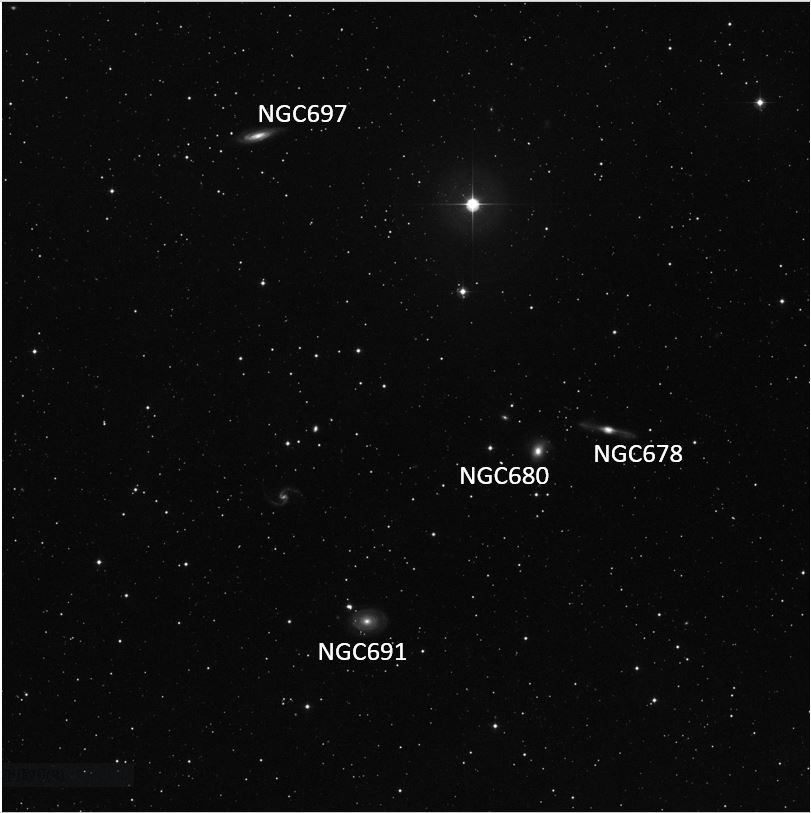
NGC697 with some galaxies around. The image is 1º wide.
The Digitized Sky Survey copyright © 1994
As usual, it is strange for me but I feel pressed when the twilight
begins. I identified NGC697, a 11th magnitude galaxy, at 3:39am 12 minutes
after the beginning of the twilight. SkySafari 6 indicated some 11th to
12th magnitude galaxies about 0.5º south-southwest of NGC697. I overlooked
them during sweeping but I confirmed them with carful second observation.
They were NGC691 and 680. I missed them due to feeling of rush steming
from the twilight and small apparent diameters, but I could have spotted
them with calm mind. Another galaxy, NGC691 also must be observable, but I
did not try to confirm.
It seems that we will have no fine day this month. I think this was the
only comet hunting session in June.
Sunday, May 24
The third comet hunting session in May. I trained my comet seeker at
alpha Pagasi, Markab where I began to search. There are many 12th
magnitude galaxies in the constellation along with 11th. I expected to
observe some of them. In actuality, I could identify none of them in 20
minutes after the start of the session. First and foremost, there are some
12th magnitude galaxies one-degree northwest of Markab like NGC7463 and
7465 that were likely to be noticed. After the session I looked into the
old record at home ant found that I have identified them on 3 June in
2016. At that time, I was in Niigata and the site was over 900m above sea
level with air temperature of 5ºC. Today's site is also more than 900m
above sea level but it was milder with temperature of 15ºC. The degree of
transparency was moderate, but the condition was worse than that in
Niigata due to greater water vapor content caused by higher temperature.
Anyway, I overlooked them this time in spite of applying Night Vision
(NV). I and probably many people thought that the weather condition is
worse in Niigata than in Kumamoto, but I noticed that in some cases
Niigata is better because of low temperature.
At 3:06am local time, finally, the first galaxy came into the FOV. It was
NGC7678, a 11th magnitude one. At 3:23am I spotted another 11th galaxy,
NGC7741. Just before the beginning of the twilight, 3:28am, I identified
NGC23 that was also 11th magnitude. I think this was the first time to
observe the galaxy, but the apparent diameter was very small and it was
challenging to distinguish it from a star with NV, 37x.
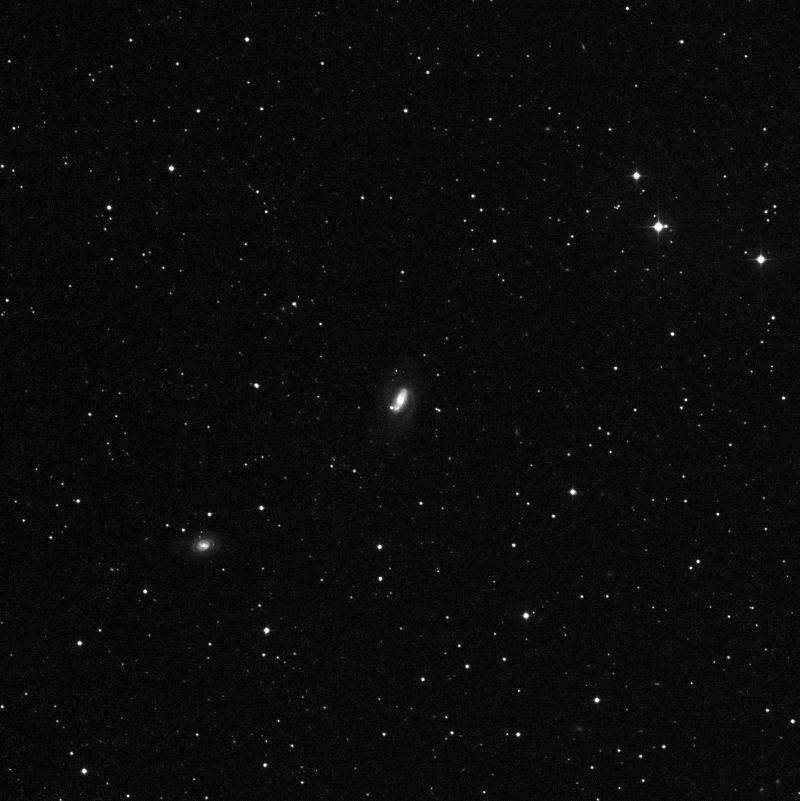
NGC23, a 11th magnitude galaxy in Pegasus. The image is 30' wide.
The Digitized Sky Survey copyright © 1994
Just after confirming NGC23, I aimed my comet seeker at C/2020 F8 SWAN.
The comet was only one degree above the horizon. I could not spot the
comet soon as it was hidden by bushes. I thought it rose higher soon and
escaped from them. Some 5 minutes after, I was sure that I looked at the
position of the comet but there existed nothing. I changed NV to a glass
eyepiece, Ethots 21 mm, and applied filters, Lumicon Comet and DAS LPS-P2
(light pollution), but I could not see it after all.
After several hours at home, I have learned that C/2020 F8 turned into
very faint image around in the day that made it impossible for me to
observe the comet. In case of C/2020 A2 Iwamoto, NV did not work at all
and I could not see the comet, but the story seemed to be different for
C/2020 F8. I wonder if there appears a new comet that NV is effective to
discover. Otherwise, I overlook a new comet due to using NV that could be
discoverable using the glass eyepiece. The answer may not be clear
throughout my life.
Wednesday, April 29
The weather condition has been poor this month, and finally, this is
the third comet hunting session in April. This predawn it was cloudless
but transparency was pretty bad. Night Vision Device (NV) is useful under
such conditions. Recently, I employ the glass eyepiece under good
transparency, less light pollution and none moonlight conditions,
otherwise I make it a rule to use NV.
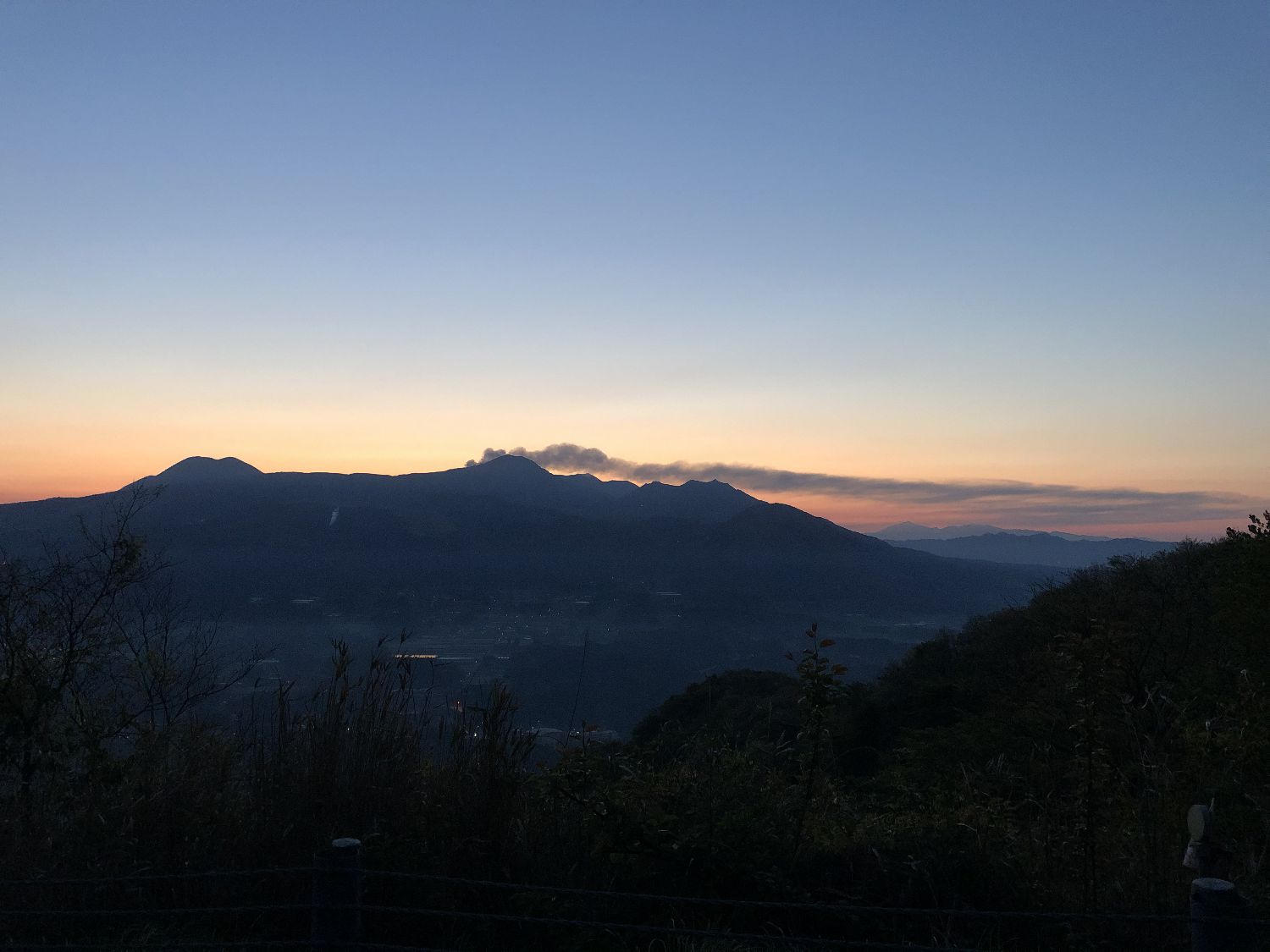
East view from the observing site https://goo.gl/maps/6Xf8iHmiRBkZQe1eA
after the comet hunting session. Volcanic smoke of Mt. Aso Nakadake
trailed southeastward.
I started the session at 3:02am local time and ended at 4:31am. The search
area ranged from 30º down to the horizon in altitude and the northern area
of M2 that covered 31.5º in azimuth. I encountered no DSOs in more than
one hour from the beginning of the session. I knew there are few DSOs in
the area. I expected that I could identify some galaxies in the
constellation of Pegasus but I felt a little bored until then. At 4:16am
local time, a quarter after the beginning of the twilight, NGC7280, a
galaxy in Pegasus with the magnitude of 12.1 came into the FOV. Though the
altitude of the object was 34º above the horizon, the image was bright
enough and I felt I could notice it if the altitude was 10º lower. Two
minutes later, I encountered a pair of 11th magnitude galaxies NGC7626 and
7619 at the altitude of 19º. At 4:23am local time I identified a 10th
magnitude galaxy, NGC7479, at the altitude of 25º. In my impression I
could not have noticed those three galaxies if I had used the conventional
glass eyepiece.
A few days ago, the object C611T11 was posted on The Possible Comet
Confirmation Page, and at present it was named as C/2020 H2 (PRUYNE). Alan
Hale observed the comet visually and he reported the magnitude as 13.2 on
2020 April 28.43 UT. I could not observe the comet today because I am not
a subscriber of CBAT circular and did not know the ephemeris. Now that the
orbital elements are announced and I want to observe the comet if the
weather permits.
Tuesday, March 24
Today I conducted the fourth comet hunting session at predawn. Prior
to the session I observed C/2019 Y4 ATLAS. The comet was 9th magnitude
with an apparent diameter of 6' and DC =3 without a tail using Ethos 21
mm, 46 cm 97x, while it was 8th magnitude, 1' and DC = 7 using Night
Vision (NV), 37xDThe image with NV showed higher DC with much smaller
diameter. Those were not precise measurements using comparison stars, but
values were determined by intuition.
NV is not suitable for observation of gas-rich comets, because it has poor
sensitivity for the wave length around 500nm. I think the coma of the
comet is mainly consist of gas, and it made apparent diameter measured by
NV smaller than that with Ethos 21 mm. Contrary, the tail was not seen by
the glass eyepiece, because I guess the tail is dust-rich. NV strongly
boosts the object image that has continuous spectrum.
That indicates there is a possibility that comet hunters cannot discover
gas-rich comet using NV; actually, I could not see C/2020 A2 Iwamoto using
NV. Having said so, some comets looked better using NV, especially under
the moonlight or poor transparency. I cannot sweepingly say that NV is not
good for comet hunting.
After observing C/2019 Y4, I began with the session using Ethos 21 mm.
However, in six minutes I stopped using the glass eyepiece due to the poor
transparency of the sky. I replaced it with NV and went on the session.
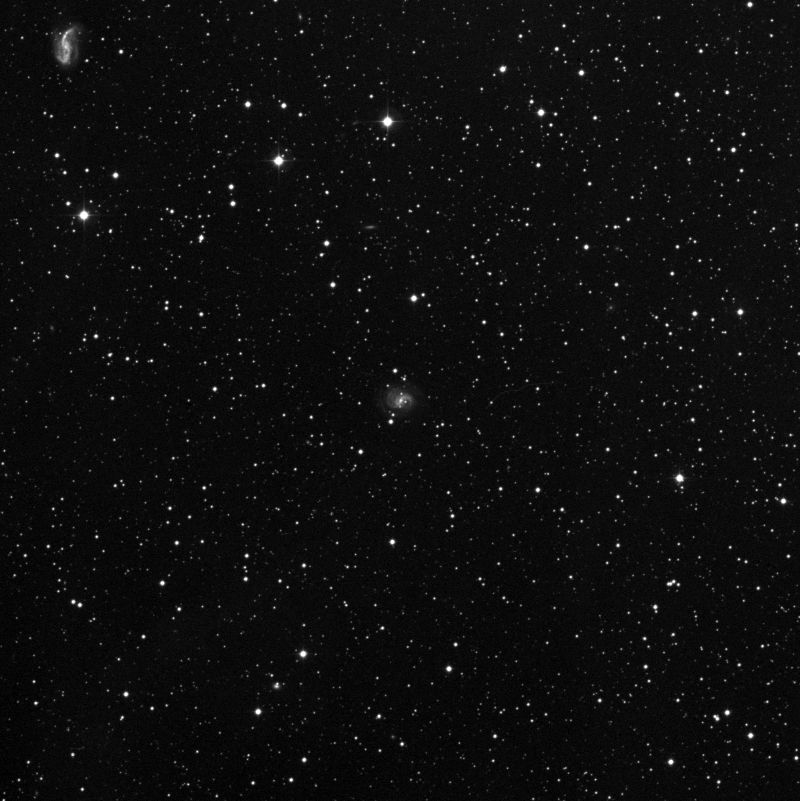
center: UGC11585, 13th magnitude galaxy in Aquila. Upper left: NGC6926,
12th magnitude galaxy. The image is 30' wide.
The Digitized Sky Survey copyright © 1994
The deep sky objects that I observed were M75, NGC6814 (11th mag. galaxy
in Aquila), M72 and UGC11585 (13th mag. galaxy in Aquila). I identified
UGC11585 at an altitude of 26º above the horizon, but did not notice
NGC6926, 12th magnitude galaxy nearby.
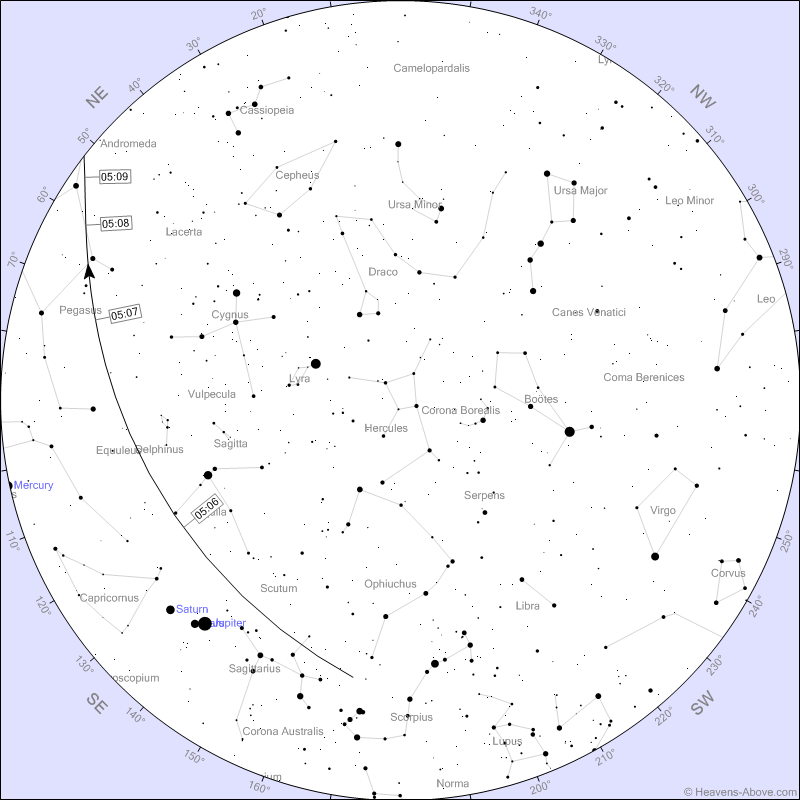
Ephemeris for Starlink Satellites, obtained from Heavens Above
https://www.heavens-above.com/?
When I looked up the sky at 5:06am local time a string of some 30
artificial satellites with the first to second magnitude and 60º in length
flew toward the east. Those were Starlink Satellites. It was my second
time to observe them by naked eyes, and I once observed them in the FOV of
my comet seeker during the comet hunting session. At that time, they were
reduced to the 5th magnitude.
Some people said it was impressive, but I feel offended at them since the
satellites affect negatively for astrophotography and radio astronomy.
There is a prevailing rumor that COVID-19 coronavirus was unnatural
origin, and I think flooding with unnatural materials makes human beings
face retaliation by nature.
Saturday, February 1 to Sunday, February 2
I went to on an observational trip to Iihoshi Green Square, Morozuka,
Miyazaki Prefecture, on Saturday Feb. 1st to Sunday Feb. 2nd (https://goo.gl/maps/as1P3PnEa4CV3UZJA@32.638306,
131.264167).
Gokase Highland Ski Resort, the
Sanctuary of amateur astronomers and one of the best observing sites in
western Japan (https://goo.gl/maps/Q6X7791Y1UwtATVs9
32.576347, 131.121868), is unavailable during the ski season. A friend of
mine introduced me the site as an alternative one. The site is 1150 m
above sea level. The relief feature intercepts the northern, the eastern
and the southern sky 15º, 5º and 10º above the horizon, respectively, but
there is no obstacle in the west.
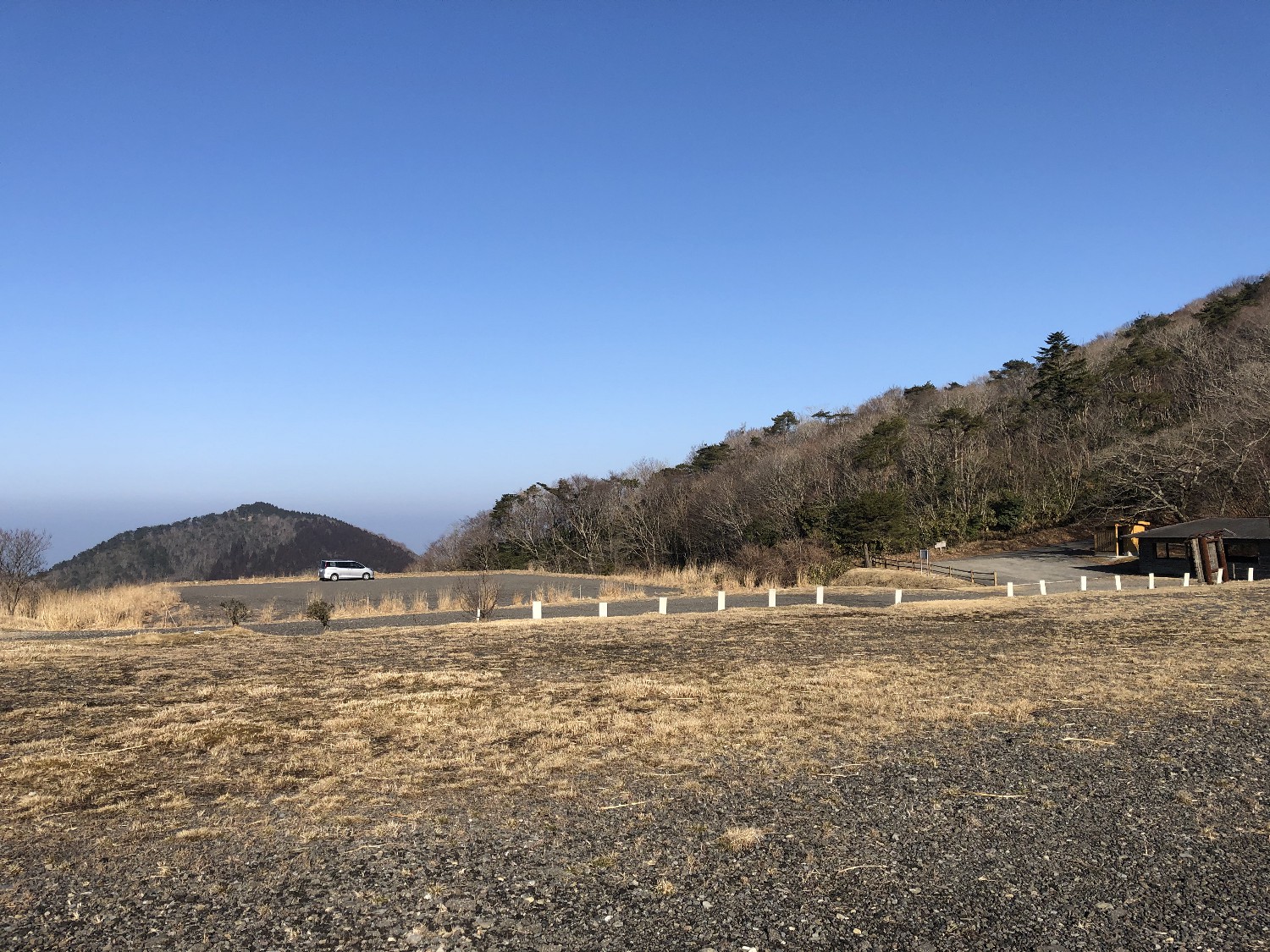
The direction of the northwest seen from Iihoshi Green Square.
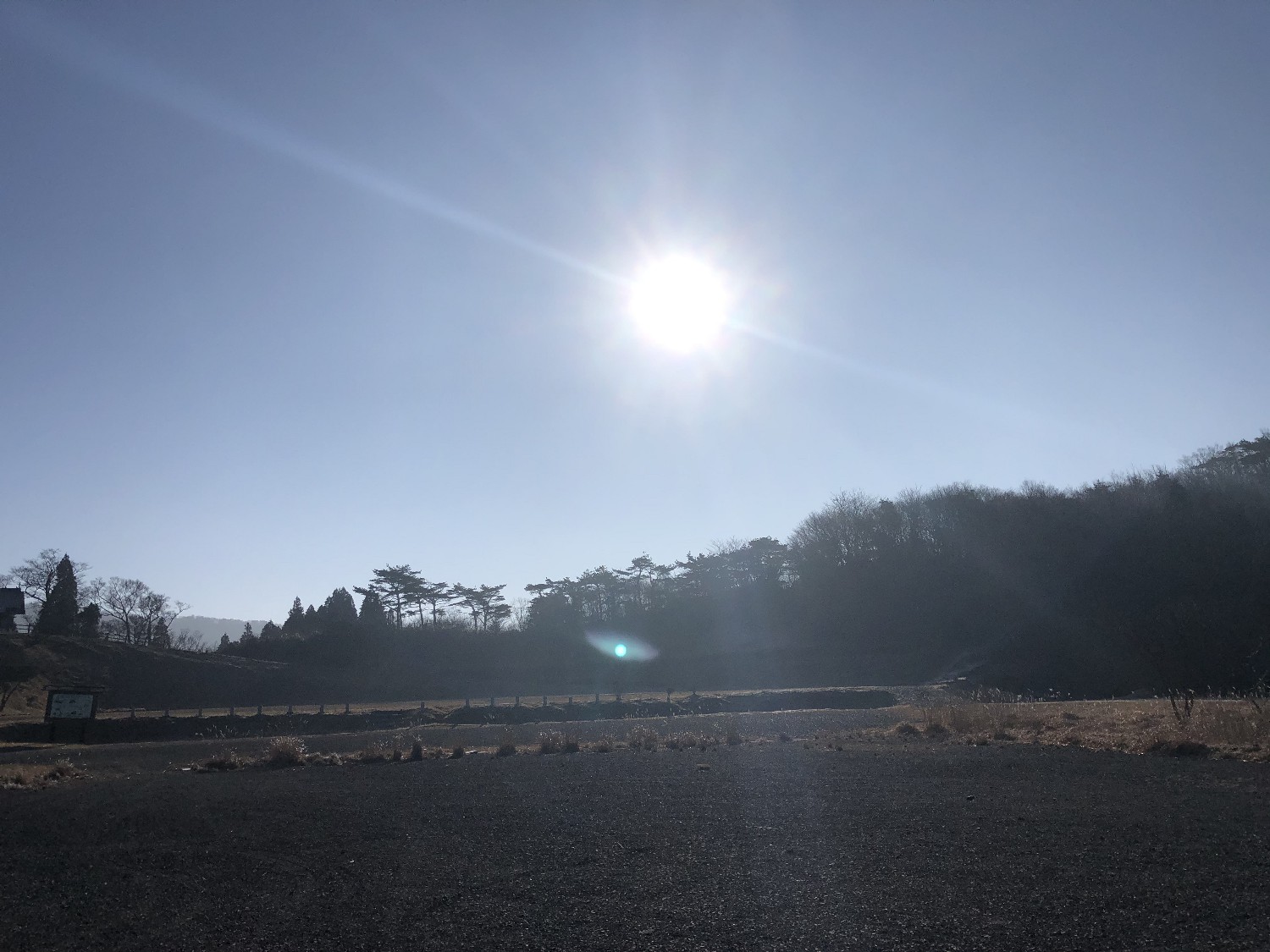
The direction of the southeast seen from Iihoshi Green Square.
I have arrived at the site at the time of sunset. The sky was clear with
breeze and the air temperature of -1º. After having supper, I set up my
telescope. I was amazed by the darkness of the sky, because I could see a
lot of stars in the sky away from the first quarter moon.
I had a plan to observe C/2018 N2 ASASSN, C/2019 Y1 ATLAS and C/2017 T2
Pan STRRS, but I was clouded out at 19:20 local time just at the end of
the twilight. I waited for a while and there appeared small cloud gaps. I
managed to observe one of the three comets, C/2017 T2. I used both Night
Vision (NV) and Ethos 21 mm. Both the images were similar but Ethos 21 mm
was better because of higher magnification. After that there was no
prospect to get clear, and I got asleep in my car.
When I woke up at 2:30a.m. local time the sky was crystal clear. I could
recognize M13 that was at an altitude of only 22º by naked eye with direct
vision. I enjoyed observing some objects using both Ethos 21 mm and NV.
M101 with Ethos 21 mm was the best image I have ever experienced. I
identified thick and clear five spiral arms, though the definition of the
number of arms is dependent on the way of counting. The impression of M101
using NV is apparently inferior to that of the glass eyepiece. On the
contrary, I had better view for M51 with NV than with Ethos 21 mm. For M97
NV did not work well but the glass eyepiece showed the luminous image.
The number of stars in M13 is less with NV. I have ever boosted the
magnification of NV using a barrow lens, but the quality of image was not
improved. Articles in Cloudy Nights read that when you use NV you should
not change the magnification but replace the optical tube assembly with
that of different aperture(s). I cannot agree more. Having said that I had
better view of Omega Centauri with NV than with the glass eyepiece.
As I mentioned above NV does not necessarily have better visibility than
conventional glass eyepiece for galaxies and globular clusters as well as
comets. I could prove the fact under the supreme sky condition.
Incidentally, I could not observe C/2020 A2 Iwamoto with NV but well with
the glass eyepiece.
After the series of observation I swept the sky not with NV but Ethos 21
mm. Nearing the daybreak the concentration of PM2.5 (particle matter 2.5
from the continent) increased that reduced transparency of the sky. The
starting point for the sweeping was M4. I encountered 16 globular
clusters, a planetary nebula, NGC6369, and an emission nebula M8, but
overlooked M62. I think it was due to the want of overlap of the FOV. How
dark the sky condition is, and how much you make your effort the discovery
is subject to slight carelessness and good or bad luck.
Tuesday, January 21
Comet Iwamoto
Masayuki Iwamoto discovered a new comet (C/2020 A2) again. I comet
hunted on Wednesday 1st and Sunday 5th this month, but it has been cloudy
and rainy after that. The forecast predicted clear sky at predawn today,
and it indeed was when I arrived at the observing site. Nevertheless, I
was clouded out soon. I stuck to observing the comet and waited for over
one hour, and finally, I was succeeded in confirming C/2020 A2 through a
gap in clouds.
As usual, I trained my 46 cm comet seeker equipped with Nigh Vision Device
(NV) 37x on the object, using Nexus DSC and SkySafari Pro6. I presumed the
comet was easy to observe, though it was at an altitude of 16º at 4:58pm
local time under the moonlight of the crescent moon; it was rather bright
with 13th magnitude located near the 8th magnitude star. In actuality, I
could see nothing at the position of the object. I had a bad feeling, but
anyway, I applied a filter as the second-best measure. In case of Comet
Machholz-Fujikawa-Iwamoto (C/2018 V1), it looked much brighter combining a
glass eyepiece with Lumicon Comet Filter. The application of a light
pollution filter, IDAS LPS-P2, to NV also improved visibility of the
comet. I tried observing C/2020 A2 using a combination of NV with IDAS
LPS-P2, but I could not. Before long, the gap in clouds disappeared.

From front left to front right: Night Vision Device (NV), Paracorr, and
Smartphone Adapter used for NV. Far center: eyepiece, Lavendura 63 mm.
I patiently waited emergence of gaps in cloud, and there appeared at
5:37am. I used a glass eyepiece, Ethos 13 mm 157x this time. Here it was!
The comet was clearly seen! The altitude of the comet was as high as 24º
at present, but I could not observe it at 4:58am not due to the low
altitude. The image of the comet was bright enough to be discoverable, mag. 12.5. "A bad
feeling" came true; I found that it is impossible to observe C/2020 A2
using NV. There are two possible causes.
First, Comet Iwamoto is visually diffused and rather faint. As described
in an article in the Sky&Telescope magazine, NV
sometimes does not improve visibility for an extremely diffused object
having a large apparent diameter, e.g. M33.
http://televue.com/Pdf/SkyTelescope_NightVision_June2018.pdf
Second, the spectral sensitivity characteristics for NV does not match
with the spectrum of the object. Most of all comets I have ever observed
using NV looked at least as bright as using a glass eyepiece or brighter.
Nevertheless, NV can have a negative effect on visibility due to a large
individual difference in the spectrum of comets.
It is unknown either of the two (or maybe both) is the cause for the
invisibility of the comet. I cannot detect the comet if I search using NV.
Is a glass eyepiece better choice for comet hunting than NV? I think the
answer is no. Overall, NV is superior.
Once H.J. Brewington discovered a new comet using Lumicon Comet Filter in
a severely light polluted city, Boston. However, the filter exerts a
negative effect for some comets. I must say "there is no royal road to
comet hunting". I think selecting equipment depending on the varying sky
condition and the way of conducting comet hunt is the best.
Top of this page
















